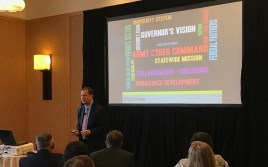California gov. signs bill setting clear digital, electronic signature guidelines

California Gov. Jerry Brown just put pen to paper on a bill aimed at cutting through some confusion in the state’s statutes surrounding how government agencies accept signatures on documents electronically.
Brown signed Assembly Member Evan Low’s A.B. 2296 earlier this month, which is designed to set clear standards around how state and local agencies can use both electronic and digital signatures.
Though the two terms may seem interchangeable, they actually represent two very different methods of electronic identity verification — an electronic signature consists of a symbol signifying that a person is agreeing to sign a document, while a digital signature joins that symbol together with a secure certificate verifying the identity of the signer. California lawmakers passed legislation in both 1995 and 1999 to allow agencies to start using these types of techniques, but Low told StateScoop that the exact language of those laws conflicted a bit and need some clarification.
“If you just think about common sense, everyday activities in the regular world, this is a thing that has been adopted quite some time ago,” Low said. “Oftentimes it takes some time for us to catch up with the time, so I was glad the governor agreed and we were able to focus on this area.”
Indeed, Dan Puterbaugh, director and associate general counsel for Adobe Systems, said he’s run across a good bit of confusion as he’s tried to work with agencies hoping to start using the signature services his company offers.
Specifically, he noted that the 1995 law was “very, very forward-looking in its day,” since it allowed government agencies to start using digital signatures for forms. The state adopted the Uniform Electronic Transactions Act four years later — following the lead of many other legislatures around the country — and though it was aimed at clearing the way to let departments use electronic signatures as well, Puterbaugh believes its imprecise definitions left government workers a bit confused.
“What we found was, even 15 years after the adoption of UETA, many, many towns, cities and government agencies in California still thought they could only use the more technically burdensome digital signatures and not the more simple electronic signatures to get business done,” Puterbaugh said. “If anything, California being way ahead of the game is the thing that caused us to have this issue.”
Accordingly, any state or local agencies hoping to cut down on its paper-based processes had to send people through a considerably more complicated system to verify their identities, Puterbaugh said.
“If they want to get Californians to apply for benefits or take any other sort of action, every single one of those Californians would need to go out and drive to a certificate authority and go through a process of giving a government ID, maybe a thumbprint so that they absolutely positively identify themselves, before they could then go back and execute agreement or file an application with the state,” Puterbaugh said. “As you can imagine, that process isn’t very appealing. If you’re interested in efficiency, interested in really trying to have next-gen processes in place, that’s not really going to move the needle.”
Puterbaugh reached out to his fellow members with the Electronic Signature and Records Association — a trade association representing electronic signature and document companies — and heard from plenty of other executives frustrated with this legal hurdle. After consulting with the secretary of state’s office, he eventually decided to bring the issue to Low.
[Read more: Virginia lawmakers move toward electronic identification]
Low said he saw the issue as a “no-brainer,” and based on his experience pushing similar legislation to let state businesses bid for state contracts electronically, he felt perfectly suited to shepherd it through the Legislature.
“We’re the state of California, we’re the global leader in innovation and our government should act accordingly,” Low said. “I was surprised, frankly, that we needed this type of legislation, so I was happy to pursue it.”
The bill sailed through both chambers of the Legislature (passing both the Senate and Assembly unanimously), and Low believes he was so easily able to earn the support of his colleagues because they’ve already started to see the value of electronic and digital signatures in “their everyday activities with banking documents or records documents, transactions, similar types of activities.”
Puterbaugh said he was also able to point to similar clarifying ordinances passed by lawmakers in both Sacramento and Palo Alto as a sign that there was plenty of demand for just this sort of law at the state level.
“I took this as a sign of clear evidence that there was a really appetite out there in California agencies,” Puterbaugh said. “They really wanted to use electronic signatures, they were looking for a way to do it, so it was a very easy choice for a legislator to make.”
Now that Brown’s signed the bill into law, Puterbaugh thinks it “throws the doors wide open” for agencies hoping to move important processes online.
“if you’re in the position of having dozens, if not hundreds, of paper-based processes in the course of running your agency or municipality, all of a sudden you’re looking at being able to move to entirely paperless processes that are dramatically faster, really, really green and you’re taking out an entire step where, very often, handwritten documents come into an agency and they are then electronically scanned,” Puterbaugh said. “You don’t need that step anymore, you’ve got a purely electronic process from end-to-end.”
As agencies start experimenting with that shift to paperless methods, Low said he’s eager to continue supporting that sort of innovation in the statehouse during next year’s legislative session.
“This is just one of the continued steps in ensuring we can be up to date, and this can provide the framework and foundation for the future of technology,” Low said. “How do we fundamentally adopt future or new technologies in a way that the consumer and the electorate knows how to use?”






